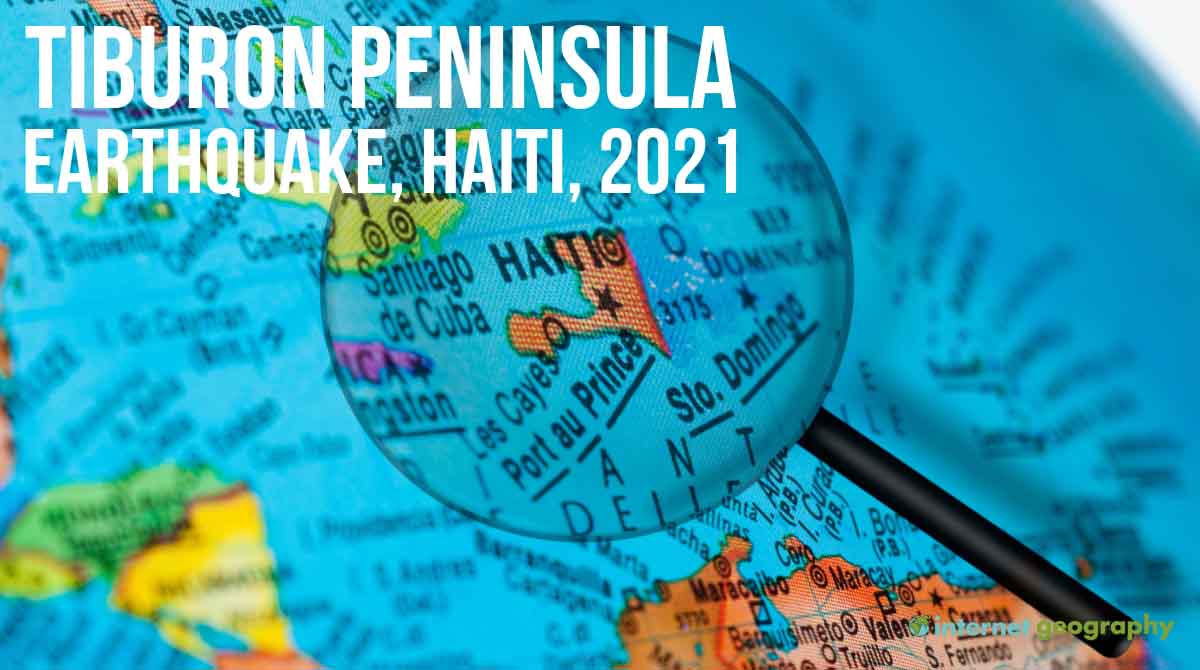When and Where Did It Occur?
In August 2021, a magnitude 7.2 earthquake struck the Tiburon Peninsula in Haiti. The earthquake was mentred approximately 150 km west of Port-au-Prince and had a shallow focus of 10 km depth.
Why Did It Occur?
The region is known for its seismic vulnerability. The earthquake occurred due to the complex interaction of tectonic plates near Haiti, where the Caribbean Plate moves eastward relative to the North American Plate.
Short-term Impacts
The immediate aftermath of the earthquake was devastating:
- Approximately 2,250 people were killed, and over 12,750 were injured.
- The earthquake resulted in widespread damage, estimated between US $1.5 and $1.7 billion.
- Over 900 aftershocks followed the main event, with significant ones occurring in 2022. These caused additional fatalities and damages.
- Hurricane Grace compounded the disaster the following day, triggering thousands of landslides and further destabilising the region.
- Significant infrastructural damage included the destruction or severe damage of 137,500 buildings, over 50 medical facilities, and 1,000 schools, particularly affecting Les Cayes, Haiti’s third-largest city.
Long-term Impacts
The earthquake’s long-term consequences have been profound:
- The primary ongoing need has been for adequate shelter, with many Haitians still displaced or living in inadequate conditions.
- There is a continued demand for basic services, such as food, water, medical care, and access to COVID-19 vaccines.
- Efforts to rebuild critical infrastructure such as communications, transport, water, sanitation, hygiene (WASH), and electrical supplies are ongoing.
- Six months after the earthquake, Haiti estimated it required around $2 billion for recovery and reconstruction, focusing on social services, housing, health, education, and food supply.
- Research into building resilience, using remote sensing and local volunteer data collection, has influenced plans to ensure that future buildings are more earthquake-resistant.
Short-term Relief Efforts
In the immediate aftermath of the August 2021 earthquake in Haiti, several short-term relief efforts were implemented to address the urgent needs of the affected population:
Search and Rescue Operations: Local authorities, supported by international teams, conducted search and rescue missions to locate survivors trapped under debris. For instance, on August 23, 2021, 24 individuals were rescued from a collapsed building near Pic Macaya.
Medical Assistance: Temporary medical facilities were established to treat the injured. Organisations like Action Against Hunger provided essential health services, including mental health support, to those affected.
Provision of Basic Necessities: Humanitarian agencies distributed food, clean water, and hygiene kits to prevent disease outbreaks and meet the basic needs of displaced individuals. For example, Haitian-led relief efforts delivered 30,000 litres of clean water daily to earthquake survivors.
Shelter and Protection: Emergency shelters were set up to house those who lost their homes, with a focus on protecting vulnerable groups, including women and children, from potential exploitation and violence. The Haiti Red Cross Society advanced relief efforts to support public authorities in response actions after the earthquake.
Infrastructure Clearance: Efforts were made to clear debris from roads to facilitate the delivery of aid and to restore communication lines, ensuring that assistance could reach even the most remote areas. The World Bank supported Haiti in rebuilding infrastructure and institutions post-disaster.
Long-term Responses
In the longer term, Haiti has focused on earthquake planning and resilience-building to mitigate the impact of future seismic events:
Strengthening Disaster Risk Management: The Haitian government has been working to enhance its disaster risk management systems in collaboration with international partners. This includes improving early warning systems, conducting regular disaster preparedness drills, and educating the public on emergency response protocols.
Building Financial Resilience: To ensure swift mobilisation of resources in future disasters, Haiti has been developing financial mechanisms, such as the World Bank’s Contingency Emergency Response Component (CERC), which allows for the rapid reallocation of funds to address emergency needs.
Community-Based Resilience Initiatives: Local communities have been engaged in resilience-building activities, such as the ‘Yes! She Paints’ initiative trains women in trade skills to reduce the deficit of skilled workers and empower women in reconstruction efforts.
Infrastructure Reconstruction: Reconstruction efforts have emphasized building back better, focusing on constructing earthquake-resistant buildings and restoring critical infrastructure to higher standards to withstand future disasters.
Policy Reforms: The government has been reviewing and updating building codes and land-use planning regulations to ensure safer construction practices and to reduce vulnerabilities in high-risk areas.
These initiatives aim to rebuild what was lost and create a more resilient society capable of withstanding and rapidly recovering from future earthquakes.

